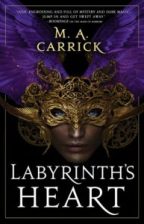 Locus: Labyrinth’s Heart is the third and final book in the Rook and Rose trilogy, after The Liar’s Knot and The Mask of Mirrors. The writing duo Marie Brennan and Alyc Helms, under their joint M.A. Carrick pseudonym, have given the trilogy a revolutionary, explosive climax – in both political and emotional terms. It’s a fantastic conclusion, but anyone coming to it without the previous books as background is rapidly going to find themself very lost. I have to salute Carrick for their inclusion of a brief ‘‘The Story So Far’’ summary, though: a year is a long time, and my memory isn’t what it used to be.
Locus: Labyrinth’s Heart is the third and final book in the Rook and Rose trilogy, after The Liar’s Knot and The Mask of Mirrors. The writing duo Marie Brennan and Alyc Helms, under their joint M.A. Carrick pseudonym, have given the trilogy a revolutionary, explosive climax – in both political and emotional terms. It’s a fantastic conclusion, but anyone coming to it without the previous books as background is rapidly going to find themself very lost. I have to salute Carrick for their inclusion of a brief ‘‘The Story So Far’’ summary, though: a year is a long time, and my memory isn’t what it used to be.
The city of Nadežra is a divided one. Set on a river delta, home to the holiest site in Vraszan – the Wellspring of Ažerais – for generations, it has been ruled by Liganti noble houses and wealthy gentry, descendants of conquerors, who set themselves above the Vraszenians whose city it once was. Ren and her sworn sister Tess came back to it with a plan: Ren would con her way into the heart of House Traementis and set them up for life. Swept up in Nadežran politics and magical disasters, Ren – as ‘‘Renata Viraudax’’ – found wholehearted welcome with, and adoption into, House Traementis, but her successful con began to weigh on her conscience as her affection for her new family grew. Meanwhile, she grew close with Grey Serrado, one of the few Vraszenian officers in the city police, a man who by night took up the mantle of the Rook, a legendary vigilante. She also found an ally in Vargo, slum-crimelord-turned-nobleman. In her Vraszenian persona as ‘‘Arenza Lenskaya,’’ Ren found herself drawn into the orbit of Vraszenian revolutionaries. And as the Black Rose – a disguise that’s a mystical gift from the Wellspring of Ažerais – Ren found herself in the centre of even more events.
In the course of which both Grey and Vargo became aware of all of her identities, and in which all three of them learned that a set of ancient artefacts – medallions drawing on the corrupting power of the Primordials, which destroyed at least one city – circulate in Nadežra. This corrupting power will do nothing good. Unfortunately, Ren, Grey, and Vargo now all have medallions of their very own, which lends a certain urgency to their need to find some way to destroy these dangerous but powerful artefacts.
This is where Labyrinth’s Heart begins. In less accomplished hands, the magical threat would be the novel’s largest focus. But while the mystical threat to Nadežra and its people is never entirely out of sight, Carrick’s just as interested in the non-mystical tensions of a city bubbling with revolutionary ferment, the sort of generational injustice that leads to explosions if you have gunpowder, and to factionalism between the bloody and the less bloody revolutionaries on how many things they should blow up. And Carrick’s just as interested, too, in the strains and consequences of Ren’s multiple identities and compounding lies, and what that means for her and her relationships. When her deceptions are revealed to House Traementis, there are a lot of consequences to reckon with, and not just for her.
The setting is richly detailed, with a deep sense of place. Carrick evokes atmosphere deftly, and Nadežra draws from the same well as Ellen Kushner’s Swordspoint and Melissa Scott and the late Lisa A. Barnett’s Astreiant series, where duellists and brawlers, con artists and revolutionaries and fortune-tellers (false and truthful) rub up against aristocrats and scholars, and slums and sewers provide counterpoint to lavish fetes and the upholstered parlours of the wealthy: the kind of sensibility that’s always struck me as a working in a very Renaissance vein, even when it doesn’t draw directly on the aesthetics of late medieval Italy.
The characters, too, are drawn with skill and compassion. We see them reckoning with their own changes in who they are and how they’re seen by the world. Ren’s unmasking to House Traementis, teased all throughout the trilogy, is an excellent piece of narrative payoff: I honestly thought she’d get away with it, but if she had, she’d never have been spurred to reckon with who she is without her (metaphorical and real) masks.
Family and heritage, of blood or otherwise, is a theme that comes to the fore, as Ren discovers truths about hers, Grey is forced to confront his birth family and a more mystical inheritance, Giuna and Donaia of House Traementis reckon with their heritage and Ren’s position in their lives, and even Vargo has to come to terms with the connections he’s made: microcosms of the same reckoning that Nadežra as a whole has to make with its past and its unjust present, in political and in magical terms.
Labyrinth’s Heart ends on a very satisfying, if unlikely, note of revolution and reconciliation: change and hope for a better future, both for the city and for all our protagonists. This is a novel full of tension and incident, colour and verve. It has style and a sense of humour, and as the capstone to the trilogy it more than lives up to its predecessors. I really enjoyed it, and I recommend the entire trilogy wholeheartedly.